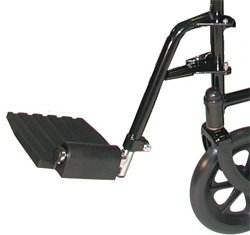Wheelchair Footrest Adjustment

Wheelchair footrests, also referred to as front rigging, are adjustable in height and properadjustment will affect the comfort of the user and the function of the wheelchair in some cases.
If the footrest length is too short the knees are elevated off the wheelchair seat and more of the user’s weight is transferred back onto the buttocks. This increased weight load on the buttocks will cause the user some discomfort over time and can lead to pressure sores.
On the other hand, if the footrest is set too low the user’s feet are not supported and the weight of the lower legs is carried by the back of the thighs at the edge of the seat upholstery or wheelchair cushion. This will also lead to discomfort for the user and the chance of skin damage where the front edge of the seat or cushion digs into the back of the thighs.
When a footrest is adjusted properly, the entire length of the back of the thighs should be in contact with the seat cushion of the wheelchair and be supporting some weight.
In the case where the lower legs are different lengths it may be necessary to set each footrest at different lengths to accommodate the user.
Footrest Ground Clearance
Wheelchair users who have long legs or low seat heights will have trouble with the footplates of the footrests being too close to the ground to clear small obstacles or actually touch the ground all the time. This is a situation that needs to be addressed when the wheelchair is first purchased.
Most lightweight wheelchairs offer a selection of standard footrests that will help deal with low ground clearance. The options available will offer different footrest angles between 60 and 90 degrees of angle.
The 90 degree footrests hang straight down from the seat frame and the 60 degree footrests extend down and forward from the seat frame at about a 60 degree angle. Many wheelchairs offer 70 degree footrests that do not extend as far forward as the 60 degree footrests.
The more forward extended the footrests (60 degree) the longer they can be adjusted without having ground clearance issues. The 90 degree footrests are only useable for children with quite short lower legs and will tend to hit the casters long before they hit the ground.
While it might be simpler to just make all footrests 60 degrees they do extend the length of the wheelchair and increase the turning radius making it more difficult to manoeuver in small areas.
Conclusion
Ideally a wheelchair user’s footrests will be an 1″ or so off the ground if they are always on solid flat surfaces or closer to 2″ if they venture onto rougher terrains while having the least forward extension possible to have the shortest turning radius.
While most people can find a combination of seat height, footrest angle and length that is functional some people may have to make compromises and should have the help of a medical professional or an experienced dealer to help with these decisions.


 Online Vendors
Online Vendors  US Online Vendors
US Online Vendors 
